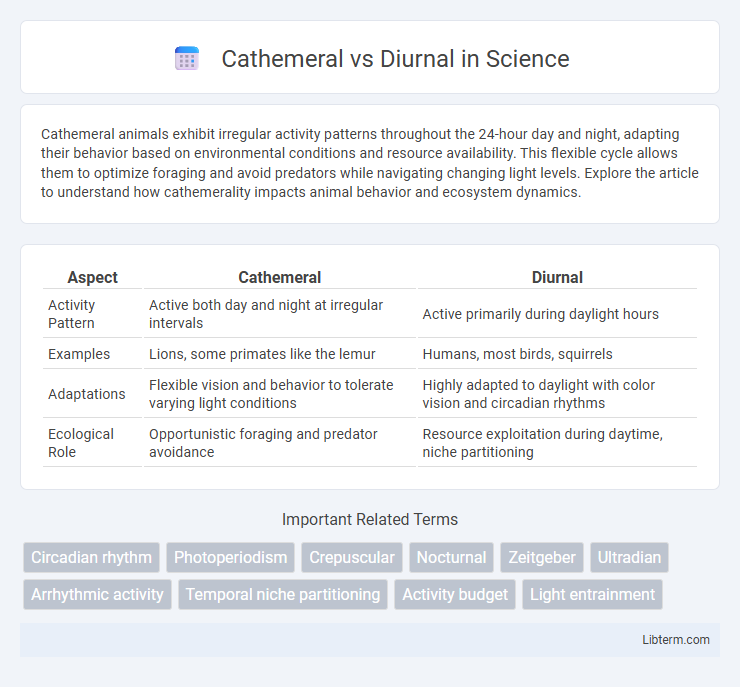Cathemeral animals exhibit irregular activity patterns throughout the 24-hour day and night, adapting their behavior based on environmental conditions and resource availability. This flexible cycle allows them to optimize foraging and avoid predators while navigating changing light levels. Explore the article to understand how cathemerality impacts animal behavior and ecosystem dynamics.
Table of Comparison
| Aspect | Cathemeral | Diurnal |
|---|---|---|
| Activity Pattern | Active both day and night at irregular intervals | Active primarily during daylight hours |
| Examples | Lions, some primates like the lemur | Humans, most birds, squirrels |
| Adaptations | Flexible vision and behavior to tolerate varying light conditions | Highly adapted to daylight with color vision and circadian rhythms |
| Ecological Role | Opportunistic foraging and predator avoidance | Resource exploitation during daytime, niche partitioning |
Introduction to Cathemeral and Diurnal Activity
Cathemeral animals exhibit irregular activity patterns, alternating between day and night, allowing flexibility in foraging and predator avoidance. Diurnal species are predominantly active during daylight hours, relying on vision for navigation and feeding. Understanding these activity rhythms aids in ecological research and wildlife conservation strategies.
Defining Cathemeral Behavior in Animals
Cathemeral behavior in animals is characterized by irregular activity patterns occurring throughout both day and night, unlike diurnal animals that are active primarily during daylight hours. Species exhibiting cathemerality, such as some primates and felids, adapt their activity based on environmental conditions, predation risk, and food availability. This flexible temporal niche allows them to optimize foraging efficiency and avoid competition while maintaining vigilance across a 24-hour cycle.
Understanding Diurnal Patterns
Diurnal patterns are characterized by activity during daylight hours and rest during the night, primarily observed in species like humans, birds, and many mammals. Understanding these patterns involves examining how environmental cues such as light and temperature influence biological rhythms regulated by the circadian clock. Research on diurnal organisms contributes to insights into sleep cycles, feeding behavior, and ecological interactions that optimize survival and reproduction during the day.
Key Differences Between Cathemeral and Diurnal
Cathemeral animals exhibit irregular activity patterns throughout both day and night, whereas diurnal animals are primarily active during daylight hours. Cathemeral behavior allows flexibility in feeding and social interactions, adapting to environmental conditions, while diurnal species rely on a consistent circadian rhythm aligned with sunlight. These fundamental differences impact ecological roles, predator-prey dynamics, and habitat utilization across various species.
Evolutionary Advantages of Cathemeral Activity
Cathemeral activity, characterized by irregular intervals of activity throughout the 24-hour cycle, offers evolutionary advantages by reducing predation risk compared to strictly diurnal patterns. This flexible temporal niche allows species to exploit food resources during both day and night, enhancing survival in dynamic or competitive environments. Cathemeral behavior also promotes better thermoregulation and energy balance by avoiding extremes of temperature common in diurnal activity.
Diurnal Adaptations in the Animal Kingdom
Diurnal animals exhibit specialized adaptations such as enhanced color vision and acute visual acuity to thrive in daylight environments, facilitating efficient foraging and predator detection. Their circadian rhythms are tightly aligned with the solar cycle, optimizing metabolic processes and activity patterns during daylight hours. Structural features like sweat glands, hair color variations, and behavioral thermoregulation further support their survival and ecological success in diurnal niches across diverse habitats.
Ecological Impacts of Cathemeral vs Diurnal Lifestyles
Cathemeral animals, active both day and night, influence ecosystems by creating continuous predation pressure and resource competition, which can lead to more stable prey populations and diverse food webs. Diurnal species primarily active during daylight contribute to distinct temporal niches, shaping plant pollination and seed dispersal patterns that align with daytime biological rhythms. The contrast between cathemeral and diurnal lifestyles drives differential energy flow and nutrient cycling, affecting overall ecosystem functioning and biodiversity maintenance.
Famous Cathemeral and Diurnal Species Examples
Lemurs, such as the aye-aye and brown lemur, are famous cathemeral species exhibiting activity during both day and night, adapting their behavior to environmental conditions. Diurnal species like the African elephant and the lion primarily engage in activities during daylight hours, optimizing foraging and social interactions. Understanding these patterns helps in conservation strategies and studying ecological roles within their habitats.
Factors Influencing Activity Patterns
Cathemeral and diurnal activity patterns are influenced by factors such as light availability, predation risk, and resource distribution. Cathemeral animals exhibit irregular activity intervals both day and night to optimize food intake and avoid predators, while diurnal species concentrate their activities during daylight hours to maximize foraging efficiency and visibility. Environmental conditions like temperature and habitat type also play crucial roles in shaping these temporal behaviors.
Conclusion: Importance of Activity Patterns in Ecology
Cathemeral and diurnal activity patterns play critical roles in shaping ecological interactions, influencing predator-prey dynamics and resource utilization. Understanding these temporal behaviors enhances conservation strategies by aligning protection efforts with species' active periods. Recognizing the importance of activity rhythms contributes to biodiversity preservation and ecosystem stability.
Cathemeral Infographic

 libterm.com
libterm.com